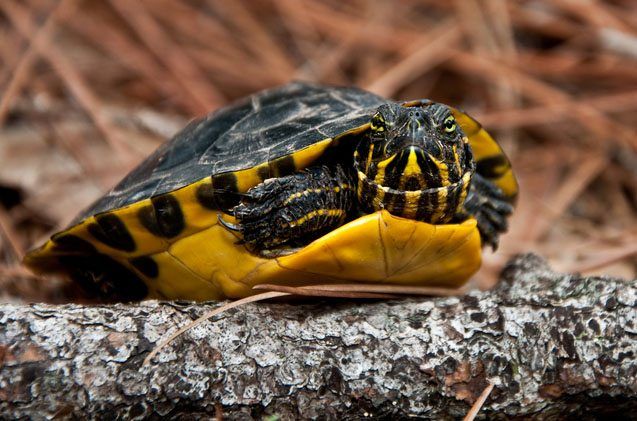
The yellow-bellied slider is an attractive species, specifically as a juvenile, and is quickly preserved in captivity. It is less popular in captivity than its cousin, the red-eared slider.
In Details
Family: Emydidae
Adult Size: Females can attain carapace lengths of near 11 inches, while males are smaller sized at approximately 8 inches.
Range: The yellow-bellied slider is found in the southeastern United States from Alabama to southeastern Virginia. It is mostly a species of the coastal plain and Piedmont regions.
Environment: The yellow-bellied slider is an environment generalist, being found in slow-moving rivers, floodplain swamps, marshes, and long-term ponds. It regularly colonizes seasonal wetlands, such as Carolina bays. It is skilled at overland travel. Throughout much of Alabama the yellow-bellied slider intergrades with the red-eared slider.
Captive Lifespan: More than 20 Years
Care Level: Intermediate
Yellow-bellied Sliders Overview
Yellow-bellied sliders do well in shallow water aquaria, according to Aetapet Blog. They need basking websites that enable full introduction from the water. A basking light that offers a temperature level or around 80 degrees Fahrenheit will be a necessity. Plastic grating or egg dog crate product supplies a good basking platform, as the plastic will not be abrasive to the turtle's plastron, and the grating will enable the plastron to dry, lowering the opportunities of shell fungus and rot.
Yellow-bellied sliders are omnivorous, however, juveniles tend to be more carnivorous than adults. Aquatic bugs, such as dragonfly larvae are consumed in the wild, along with crayfish and snails. Hostages will readily consume turtle pellets, chopped meat, lettuce and fruits.
Yellow-bellied sliders are long-lived turtles, and specimens originally captured on the Savannah River Site during the late 1960s and 1970s, are still recaptured.









